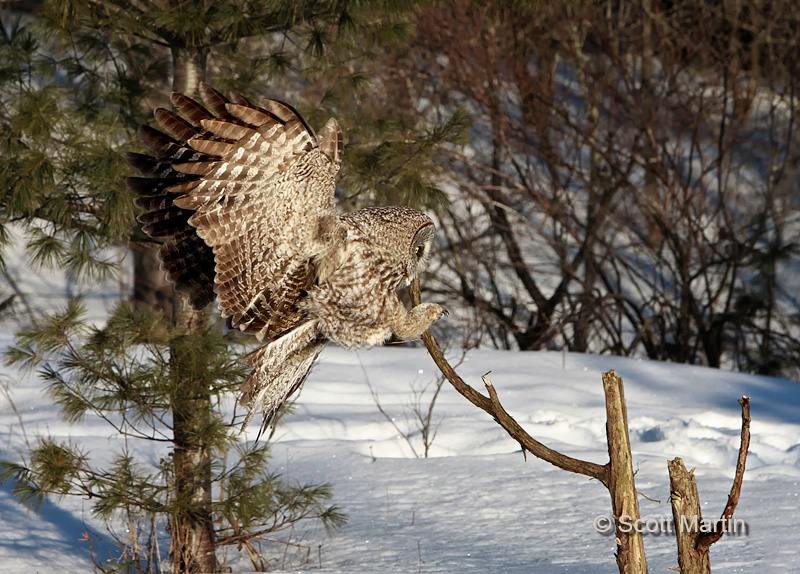
by Scott Martin Photography | Feb 21, 2013 | Birds, Blog, Raptors
Last Friday Deb & I headed to Ottawa for the first half of Family Day Weekend. It was our first time in the nation’s capital in many years and the timing was perfect as it was also the last weekend of Winterlude, Ottawa’s famous winter carnival. We were able to see the Parliament Buildings, take in the ice sculptures in Confederation Park and walk along the Rideau Canal, where I also enjoyed Ottawa’s most famous food, the Beaver Tail.
The primary reason we made the four-hour drive to Ottawa was to photograph Great Gray Owls, of which there are more than usual in Ottawa this winter. Great Gray Owls typically nest and live much farther north (as far north as the Arctic Circle) however during the winter months in years that the food supply in the north is restricted, (or the Great Gray Owl population exceeds what the food supply can deliver), younger Owls that can not effectively compete with adult birds for food are displaced southwards until they arrive at areas where food is plentiful. Once they find a location with an adequate food supply they typically stay until returning to the north in time for nesting season.
Although the owls were located in a well-known location about 15km from the downtown core, getting to the birds involved a twenty-minute hike from the closest place available to park the car. It seemed even longer as we made the trek before sunrise in -17°C temperatures carrying about 30 lbs of camera gear! Watching the sun rise for another day is always a special time and we were reminded of Psalm 118:24 “This is the day the LORD has made; let us rejoice and be glad in it”….which is exactly what we did!
The best light for taking pictures is during what are known as the ‘Golden Hours’ just after sunrise and just before sunset. When the sun is low to the horizon, it is softer and warmer appearing which makes photographs far more appealing than when taken during the mid day hours when the light is harsh. It may seem too early when you are leaving in the dark with your camera gear, but it is always worth the effort!
We were fortunate to see two Great Gray Owls and spend about three hours photographing them. Great Gray Owls are the largest North American Owl and some say largest in the world, measuring over three feet high with wing spans of up to seven feet. I the north their diet consists mostly of Ptarmigan while in the south that changes to voles and mice, of which they can eat up to twenty per day.
I trust you enjoy the photographs of these magnificent raptors and as always, you comments are much appreciated.

.
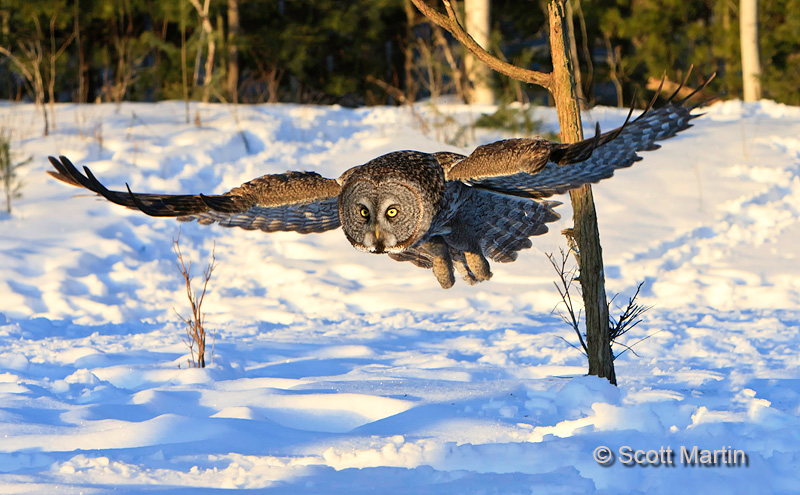
.
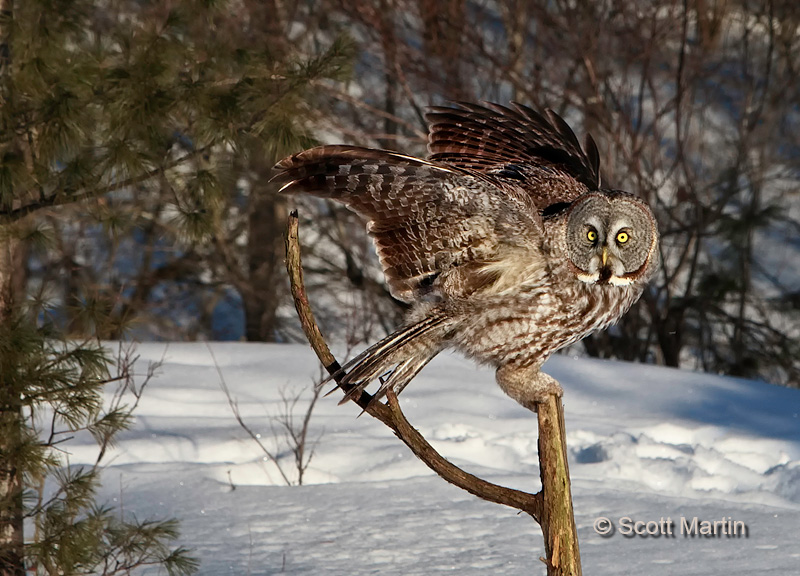
.
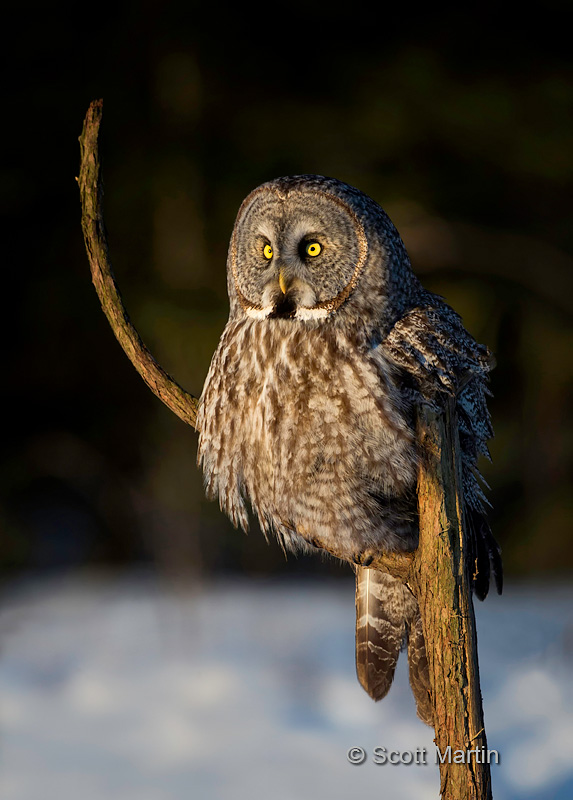
These images were taken with either a 5D Mk III and 500mm f/4 lens or a 1D Mk III and 70-200mm f/2.8 lens.
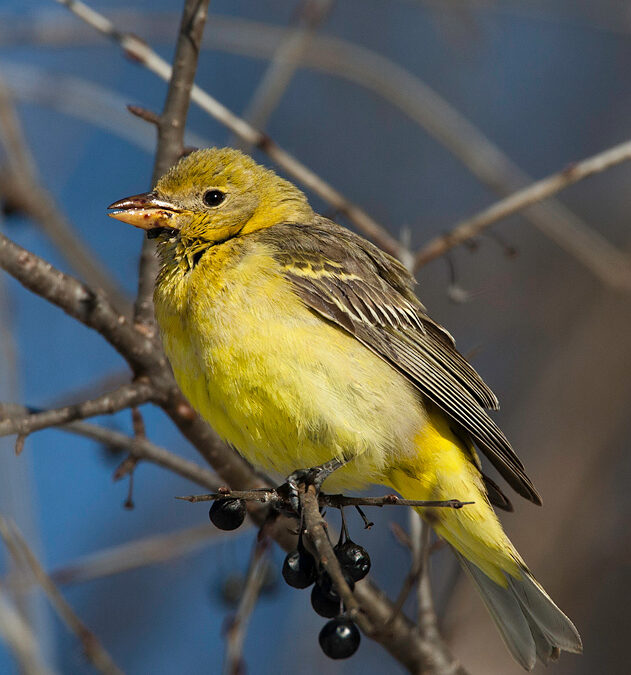
by Scott Martin Photography | Dec 31, 2012 | Birds, Blog, Educational, Song Birds
Once again it is hard to believe that another year has quickly slipped by and we are heading into 2013 in just a few hours. Its been an exciting and busy year for our family yet we are looking forward to what awaits us next year. It has been an unusually long time since our last blog entry but hopefully as I get caught up with all the image processing that seems to clog up the Photoshop ‘in-basket’ the posts will become more frequent in the New Year.
For the last couple of weeks our city has been home for a bird that is very rare in this part of North America, the Western Tanager. Yesterday I was able to catch some shots of her in good light on relatively clean perches; both of which are great joys for a bird photographer!
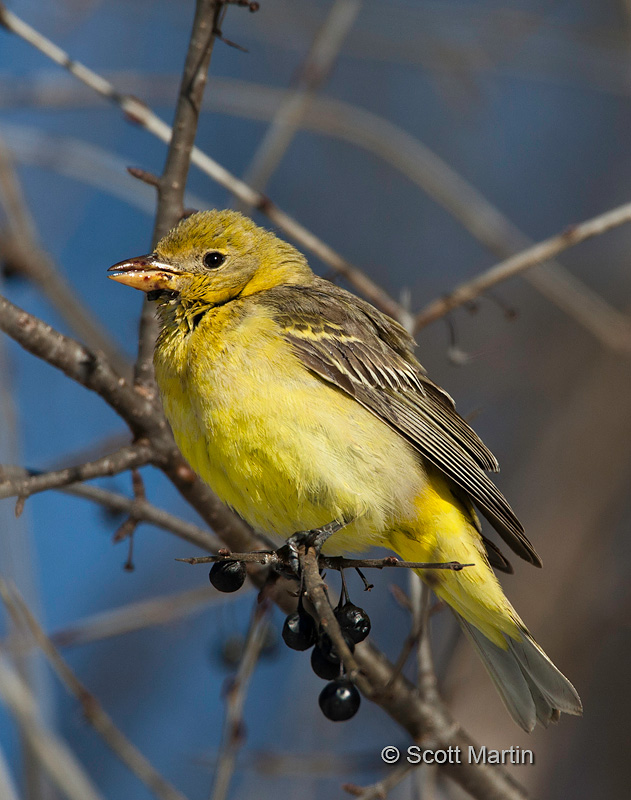
The Western Tanager is a fairly small bird generally about six inches long and weighing an ounce! They live on the North American west coast and migrating to South America for the winter. They are rarely seen east of the mid western States so when one shows up in Ontario it creates a lot of interest in the birding community with many people travelling hours to catch a glimpse. Fortunately this bird is less than five minutes from our house. Western Tanagers have bright yellow bodies with darker backs and their wings have two wing bars, an upper yellow bar and lower white bar which you can see on the image above. The male has a bright red head while the female’s is an olive-green colour. The following image also shows the distinctive wing bars.
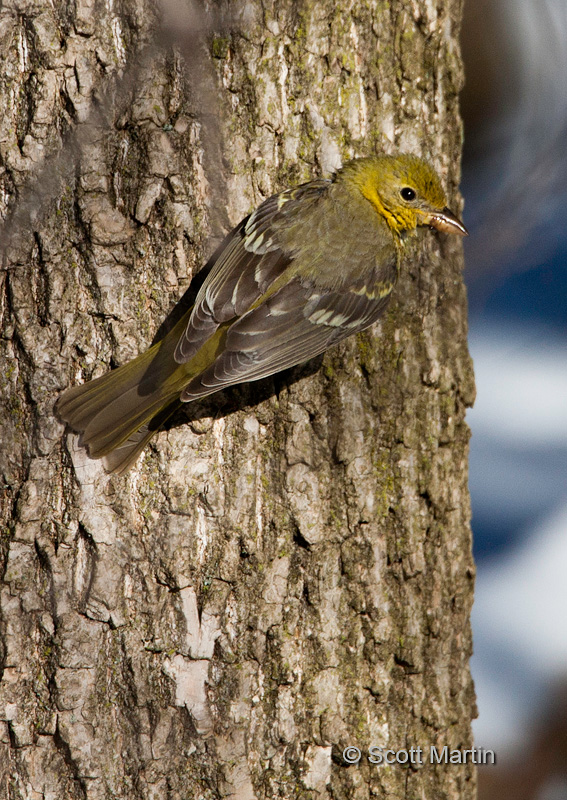
The Western Tanager typically feeds on berries and small insects, which it forages for on tree bark (as above) or, like swallows can catch in mid-flight. Given the cold weather & snow it is surprising this bird is staying around, however there are lots of berries in the area she is staying and given the fact she is thoroughly lost and on her own, she may not know which way to head so will choose to winter here as long as food is plentiful.
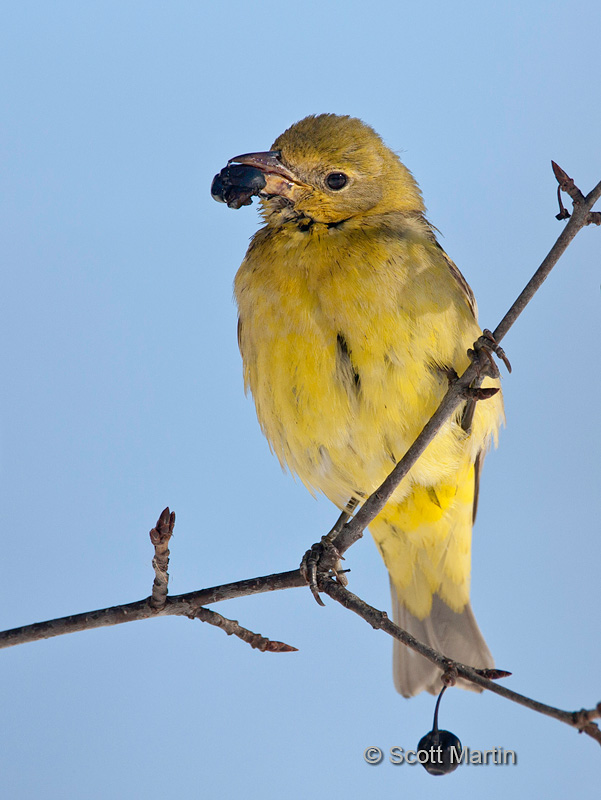
.
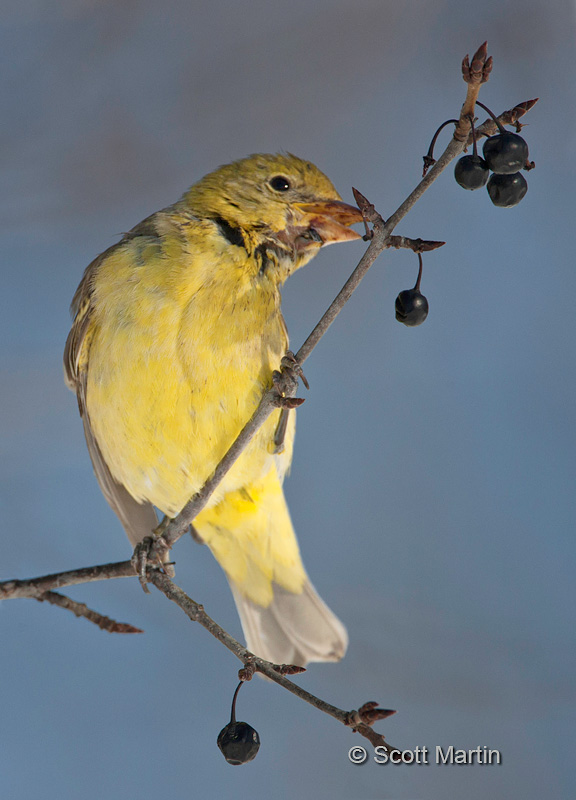
.
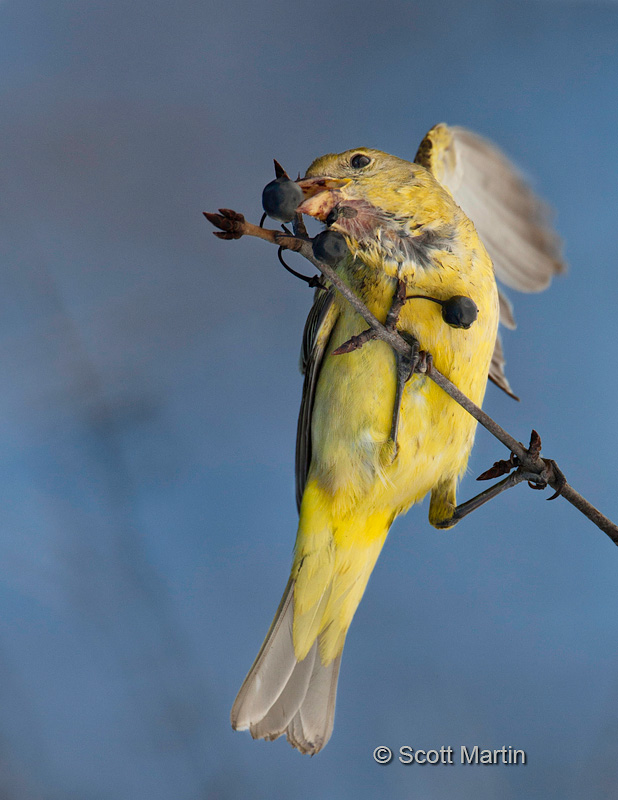
From a photography point of view, back grounds are almost as important as the subject in terms of getting the best photographic results. A nice perch and uncluttered back ground is generally the goal however almost impossible with the smaller songbirds which are usually foraging in bushes low to the ground. This Western Tanager was very cooperative and gave some good poses against a clear sky. Its imperative that you get the right exposure on the bird when shooting them against the sky and that typically means over exposing what your camera meter indicates by one or two f-stops.
The last two images have busy back grounds however show the bird in a more natural environment doing what she does as much as she can, relaxing in the sun in a location sheltered from the wind and then enjoying another berry.
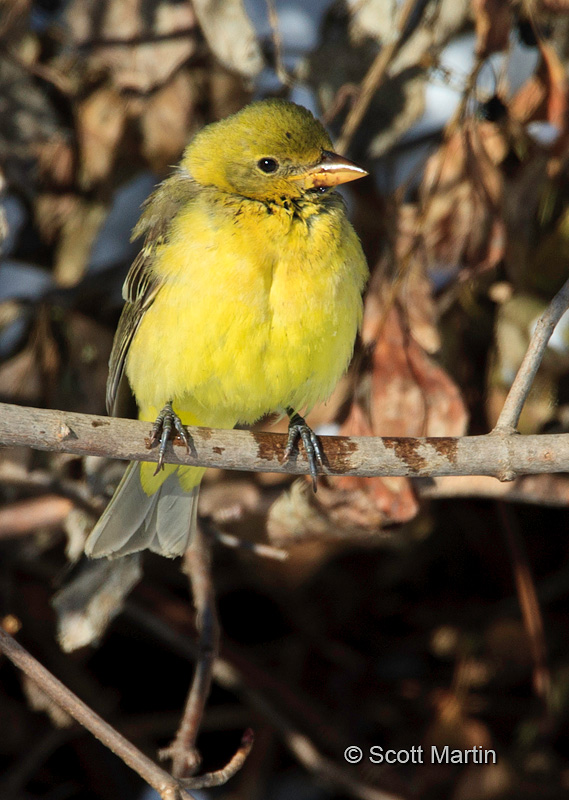
.
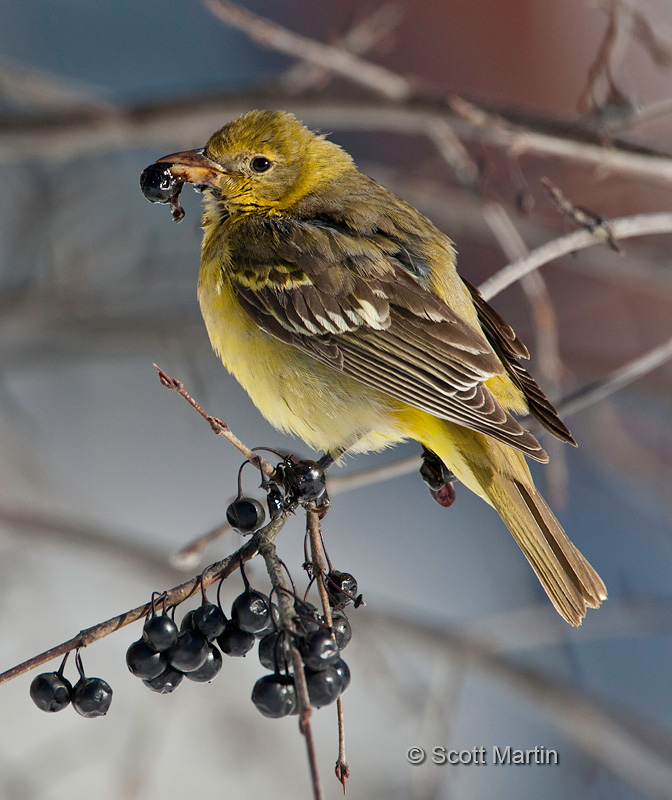
All of the images above were taken with a Canon 1D MKIII and 500 mm lens + 1.4x TC mounted on a Jobu monopod with a Jobu Jr. gimbal head.
Thank you to all my many friends who have taken time this past year to drop by and check out the website. Thanks also for your comments and questions which are always appreciated. To everyone, Deb & I wish a very Happy New Year and I look forward to hearing from all of you in 2013.
UPDATE January 3, 2013 – I’m sad to report that this bird was found dead yesterday in the park it had called home for the past couple of weeks. Not certain of the cause however it may have succumbed to the cold weather.
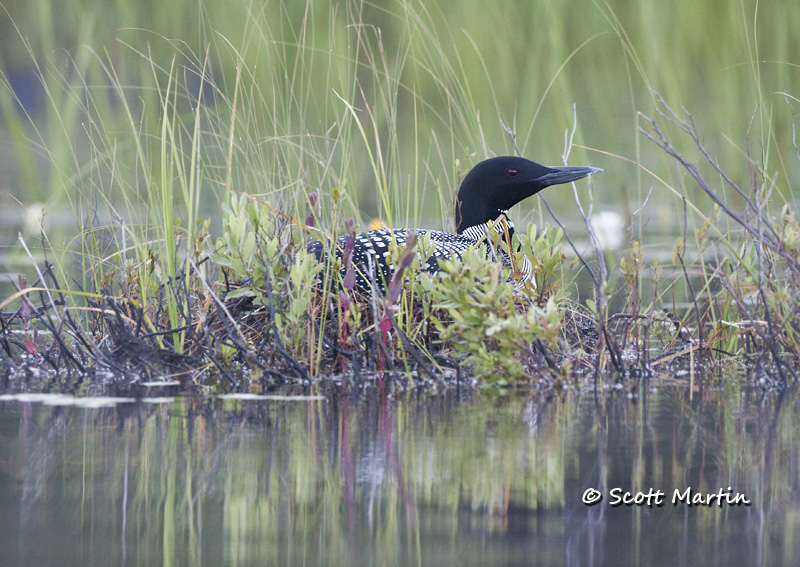
by Scott Martin Photography | Jul 10, 2012 | Birds, Blog, Loons
Over the past few years Deb and I have spent many early weekend mornings in June travelling about sixty kilometres from the cottage to Algonquin Provincial Park and then paddling a couple of kilometres in order to observe and photograph the Common Loon. June is typically the month that Loons are nesting and for the first few days after the chicks are born they spend a lot of time on their parent’s back providing a very desirable photo opportunity.
Loons are an amazing bird God designed to live on the water. They have solid bones and legs that are positioned far back on their bodies allowing them to dive and swim underwater with incredible speed and agility at recorded depths of more than 120 feet. Their design is so tailored to water that they are quite dysfunctional on land where they can only move around by a hopping and pushing themselves on their chest. They are unable to achieve flight from the ground and are only on land while nesting for the 26-31 day incubation period before their eggs hatch. Both parents share in the incubation responsibilities. Loons build their nests on the water’s edge so that they can gain access to it direct fly from the water and the young chicks can easily transition to the water; which they do the day they are born, never to return to the nest. Below is a typical nest located on a small ‘island’ not much bigger than the nest, located about twenty feet from shore and creating an important barrier to protect against predators.

As the Loon chicks move onto the water within hours of their birth, their small size and lack of development requires that they spend much time on a parent’s back for the first week of life. This allows them to rest and keep warm. They also float around on the water, always within a few feet of one of the parents. The parents keep within sight of each other and attend to the young by bringing small fry to them on a seemingly systematic schedule.
They are a pleasure to watch, and the effort required to see Loons up close is always worth it.
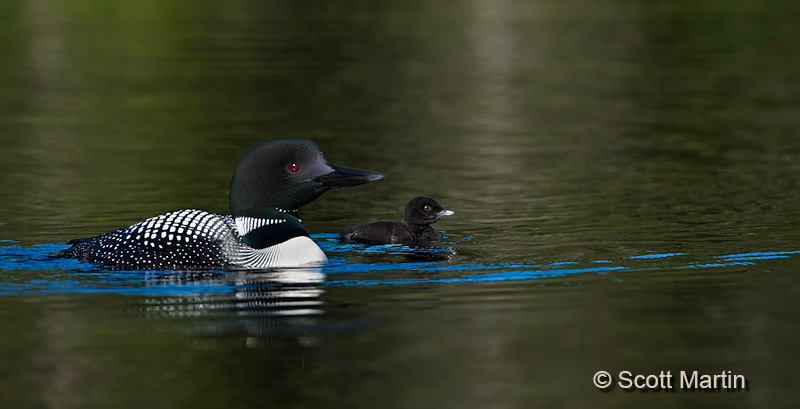
.
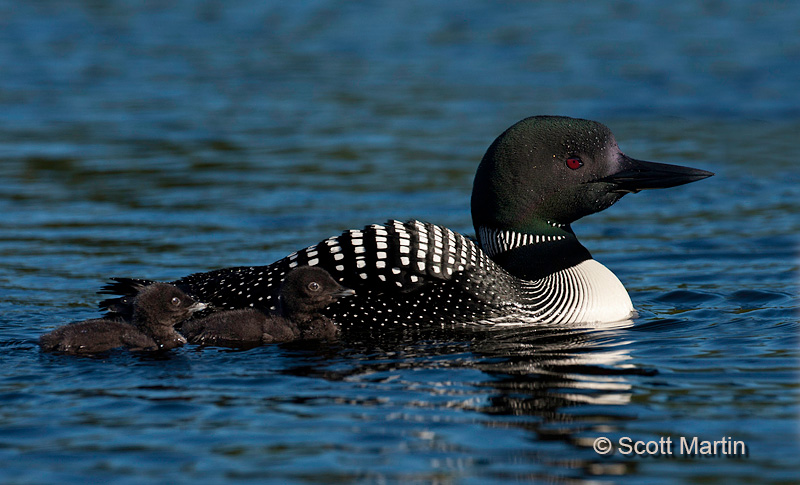
.
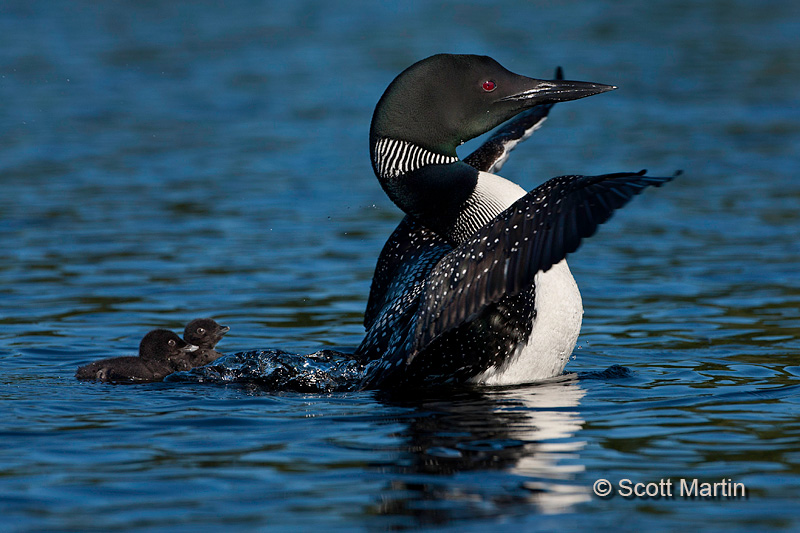
Watching the young chicks get fed is the prefect time to see the special bond between parent and offspring.
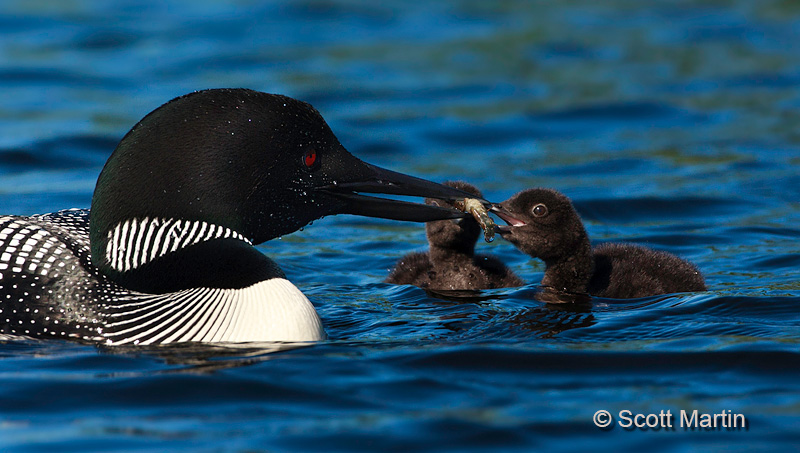
.
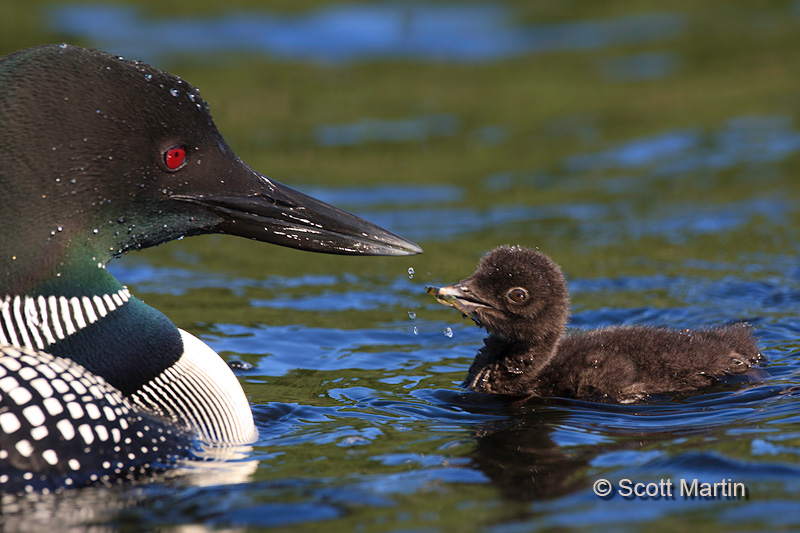
.
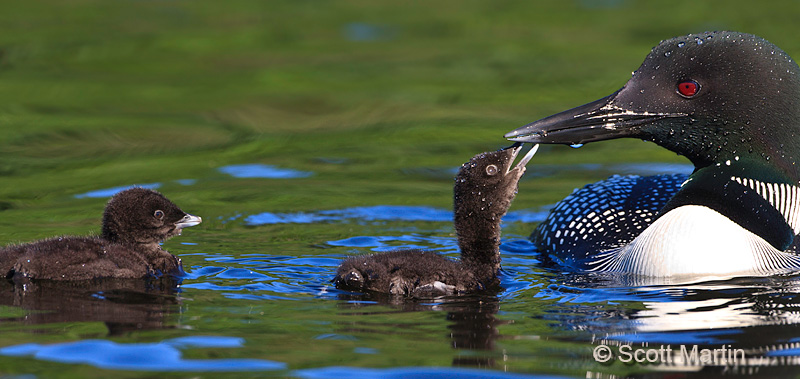
.

.
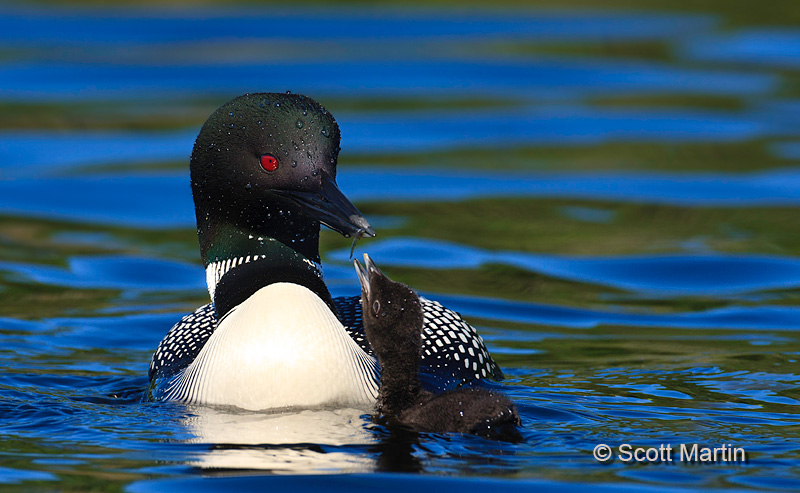
.
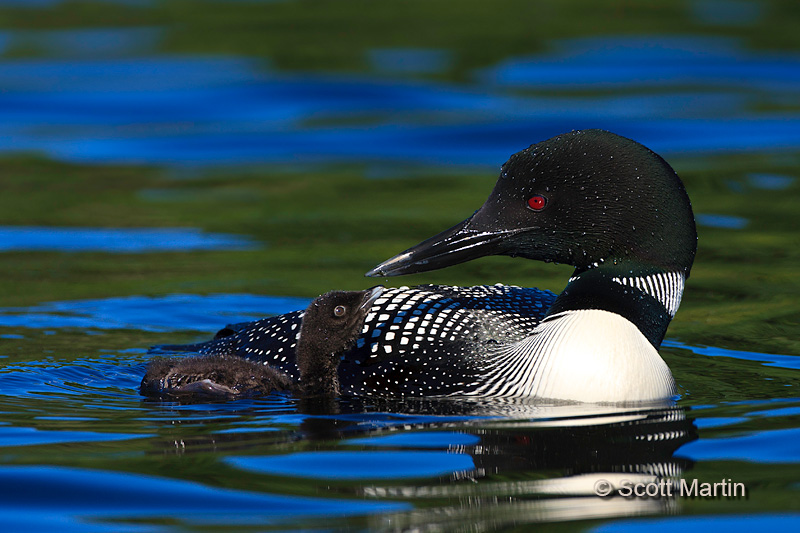
To see the chicks resting on a parent’s back and being sheltered, warmed and protected under a wing was something we’d been hoping to see for the past number of years so the following images are among our all time favourites.
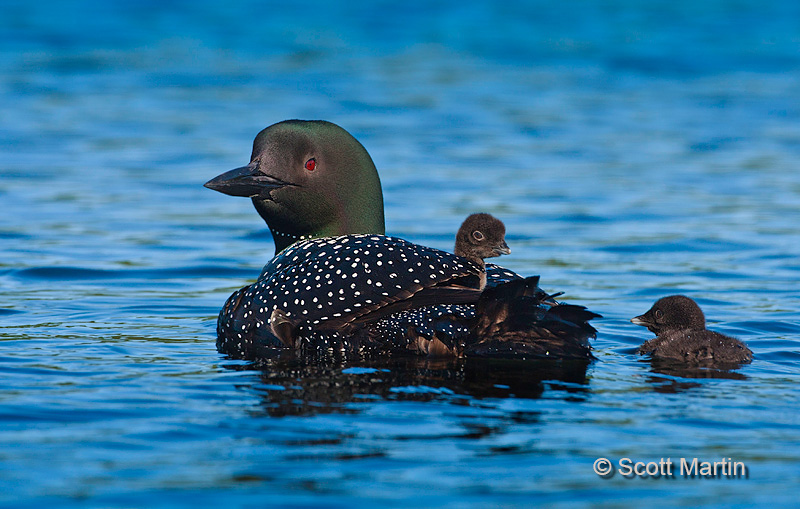
.
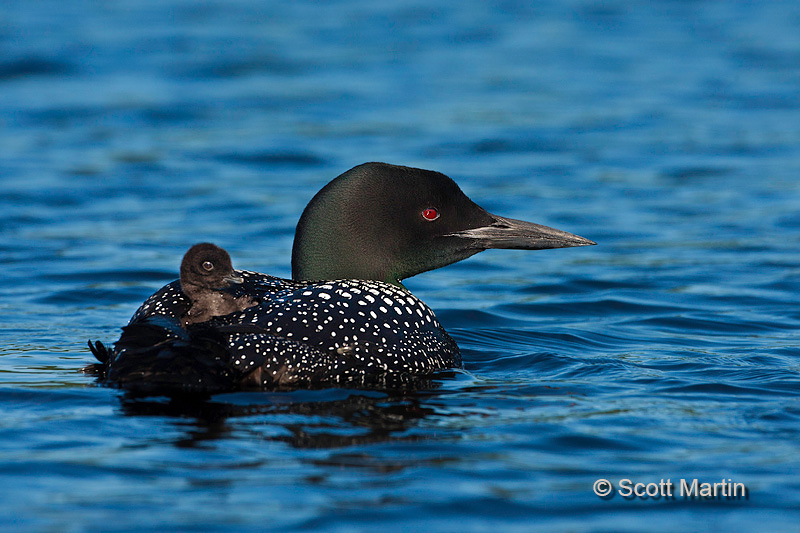
One of the chicks launching off mom’s back.
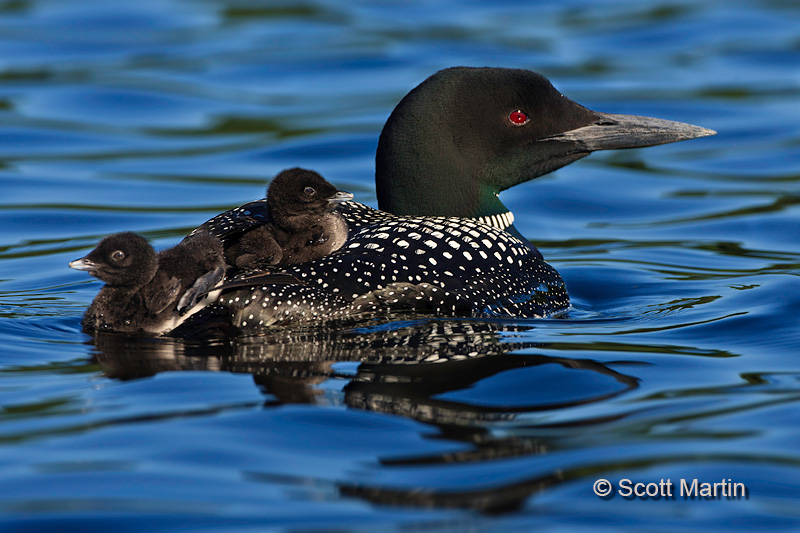
.
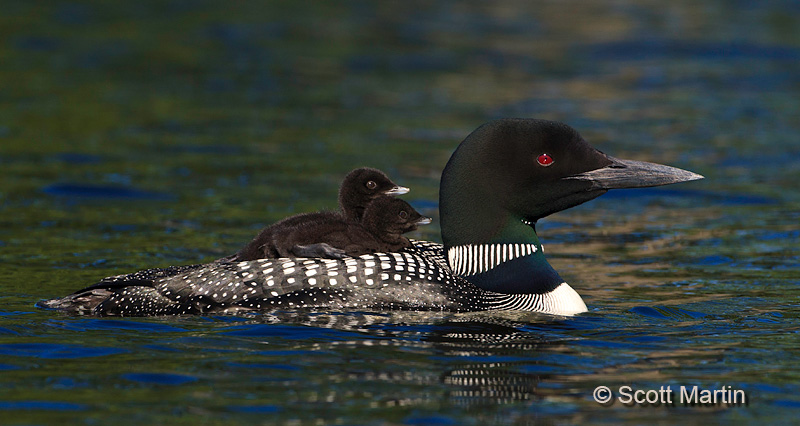
.
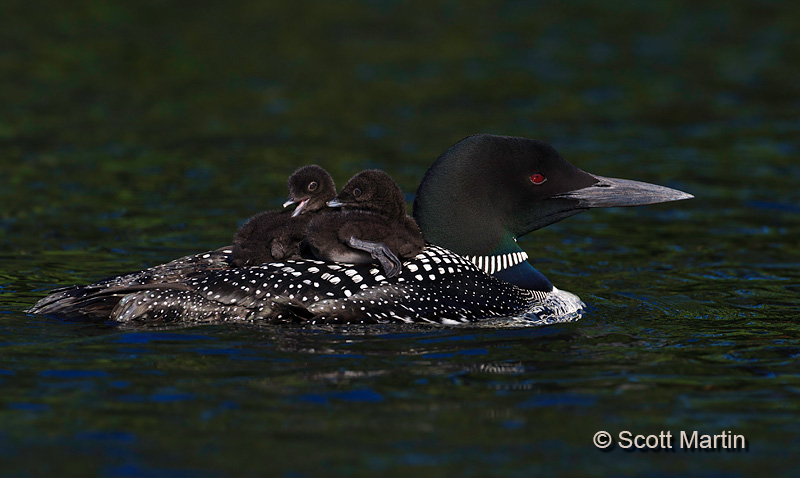
.
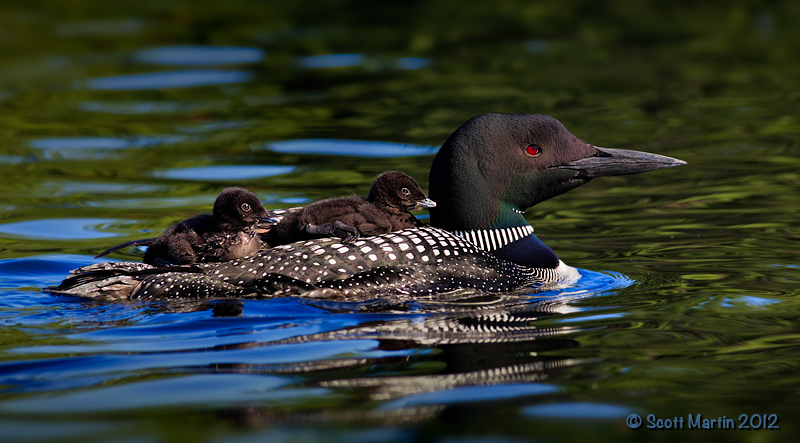
“Hey some day you will be able to do this too”!
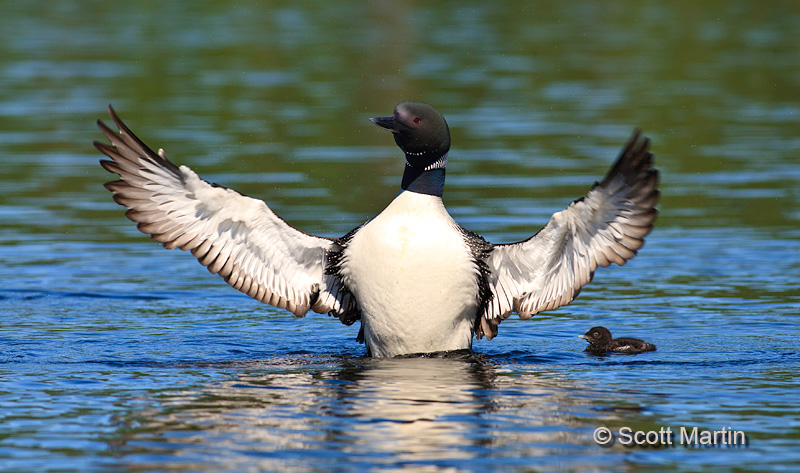
Family shot.
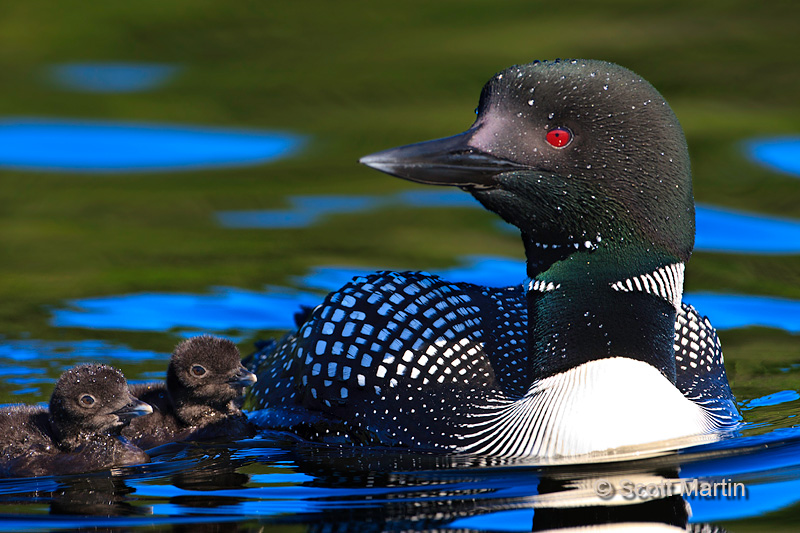
Although it’s a bit precarious taking lots of expensive camera gear in a canoe and quite a challenge to photograph from one, there are not many other ways to get close to Loons. All the images in this post were taken hand-held from a canoe with either a Canon 1D MK III & EF 500mm f4 L IS lens or a Canon 5D MK III and EF 400mm f5.6 L lens. I must thank Deb for single-handedly paddling and positioning the canoe so that the light was always right as we followed these Loons for about three hours. We are a great team but she does all of the work while I snap pictures!
If interested, more images can be seen in the Loons & Grebes Gallery
Please take the time to leave a comment as they are always appreciated and if you have any questions please don’t hesitate to ask.
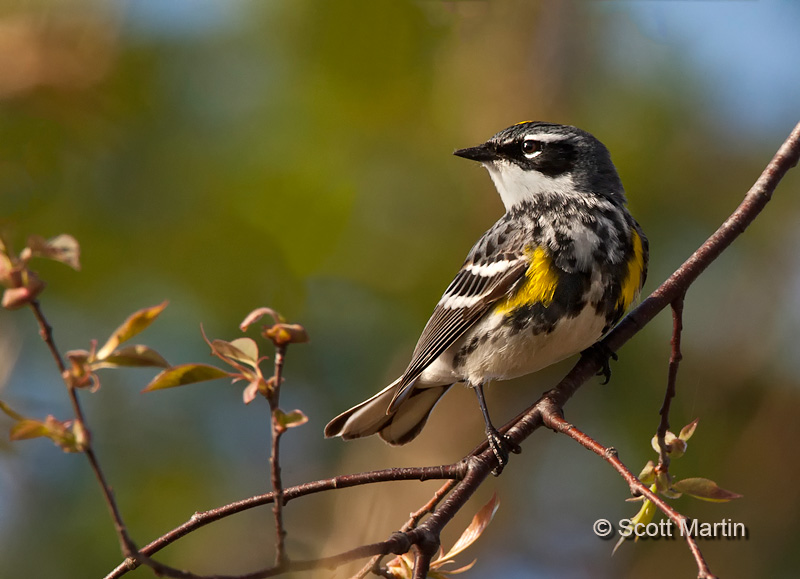
by Scott Martin Photography | May 8, 2012 | Birds, Blog, Educational, Sparrows, Warblers
Although I haven’t had much time to get out with a camera, its great to see the Spring migrants starting to show up in large numbers, especially the Warblers. More than twenty species have been seen in our area and fortunately the leaf cover is still sparse enough that you can catch a good look at most of them. That will all change in the next few days as the leaves and ground cover reach full bloom.
We spent last weekend at the cottage, getting it ready for another summer and it was a pleasant surprise to have a number of Yellow Rumped Warblers in the trees by our deck. Although one of the most common warblers, they certainly are pretty, especially when they pose for you!

This next shot of a Red Winged Blackbird that didn’t want his picture taken is from Cranberry Marsh which is just off Lake Ontario in the south end of the Lynde Shores Conservation area in Ajax, Ontario.
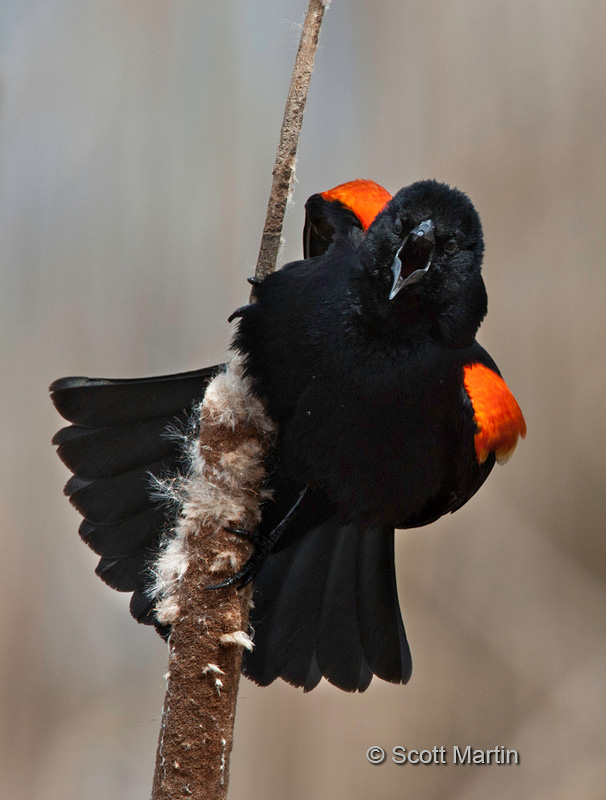
Two photographers whose blog I follow are Darwin Wiggett and Samantha Chrysanthou and one of their recent blog postings talked a lot about using different crops to enhance images, including the square crop. This White Throated Sparrow shot provided a good opportunity to practice with a square crop.
This image was taken in Thickson’s Woods in Oshawa and the Sparrow landed on a very interesting perch, nicely separated from the back ground. The problem is the perch overwhelms the small bird, which is normally a ‘no-no’ for good bird images. Typically you can minimize the large perch by cropping the photo to minimize the visual impact of the perch, resulting in this typical landscape oriented crop.

After reading Darwin’s blog on square crops, and quite liking this large perch, I decided to re-do the little sparrow on the big perch in a square format.
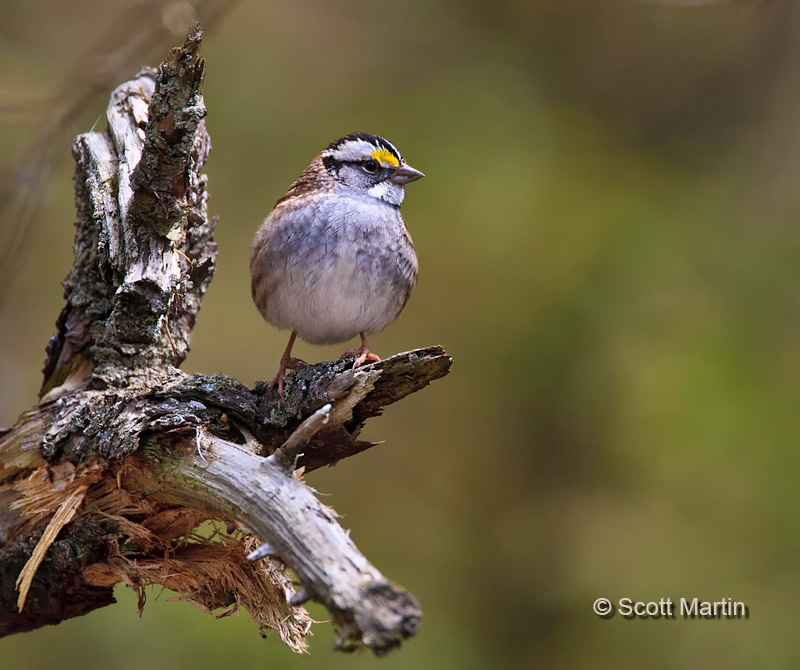
It is always a good practice to think outside the box and break down some of the traditions we photographers cling to, especially when it comes to composition and all the other ‘un-written’ rules of photography.
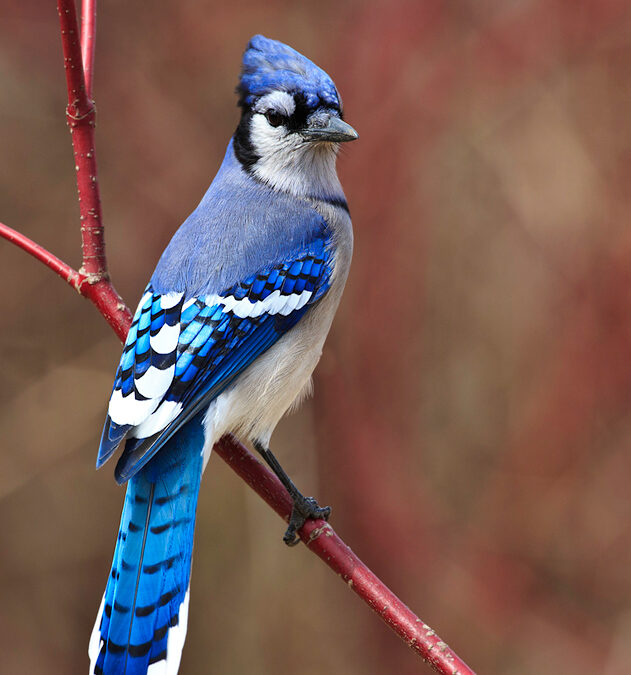
by Scott Martin Photography | Apr 27, 2012 | Birds, Blog, Educational, Sparrows, Woodpeckers
Canon is clearly the global leader in DSLR sales, with $10.5B in sales in 2010 compared to second place Nikon with $2.5B in sales. Sony places a distant third in the pecking order. A number of months ago Canon announced the release of two new camera bodies, the 1Dx and the 5D Mk III, Both of these bodies have full frame sensors, meaning that the size of the electronic sensor is the same as the frame size of the old 35mm SLR film cameras (36x24mm). The vast majority of DSLR’s sold today have smaller sensors, which results in the sensor ‘seeing’ a smaller field of view than would be seen with a 35mm film camera having a lens of equal focal length. The quantification of this phenomenon, called the Crop Factor, is made by determining the ratio between the diagonal length of the reference sensor size and the diagonal length of the smaller sensor. With crop body DSLR’s the crop factor is typically 1.3 or 1.6 for Canon cameras and 1.5 for Nikon cameras. The crop factor allows the photographer to calculate the effective focal length of a lens on a crop body camera compared to that same lens on a full frame camera. For example if a 50mm lens is attached to a DSLR with a 1.5 Crop Factor, the 50mm lens will perform as a 50 x 1.5 or 75mm lens would on a film body.
You may be saying to yourself “Who cares”, however it does make a difference based on the type of photography you do. For example landscape photographers often want to capture as large a field of view as possible and therefore use wide-angle lenses (shorter focal length lenses) to accomplish this. Right away it becomes evident that crop body cameras are a detriment if the widest possible field of view is desired. A 16mm lens effectively becomes a 25.6mm lens on a 1.6 crop body. This is why nature photographers prefer full frame DSLR’s for landscape work. The bird photographer on the other hand finds that the crop body is a great help to getting better shots because of the advantage gained by the crop factor. My 700mm lens effectively becomes an 1120mm lens on a 1.6 crop body.
The problem with photography becomes what to do when buying a camera if you are both a landscape and a bird photographer. There is an easy answer to this question…..buy two cameras, a crop body and a full frame body! Besides, if you are a serious photographer, you really should have some redundancy in you gear. If your only body broke while shooting a wedding it would be a disaster, so a second body is always a good idea.
Anyway, in order to heed my own advice, a Canon 5D Mk III was added to the gear bag a couple of weeks ago and so far its been a pleasure to use and fun to be playing with the first full frame camera since selling my old EOS 630 back in the early nineties. The new 5D Mk III has a 22.4 megapixel sensor and Canon’s new 61 point auto focussing system which is surprisingly fast. It’s ISO range of 50-102,400 is amazing and means this camera almost sees in the dark! Another new perk for me is that the 5D also shoots full HD video which is going to be fun.
The following images are among the first taken with the camera and have not been processed other than converting and resizing the RAW files for display on the web.
Blue Jay
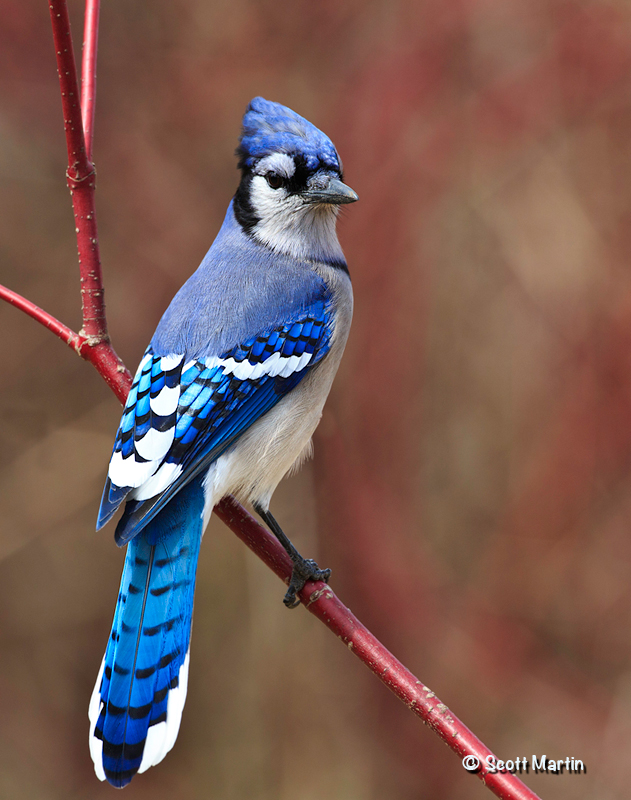
Downy Woodpecker
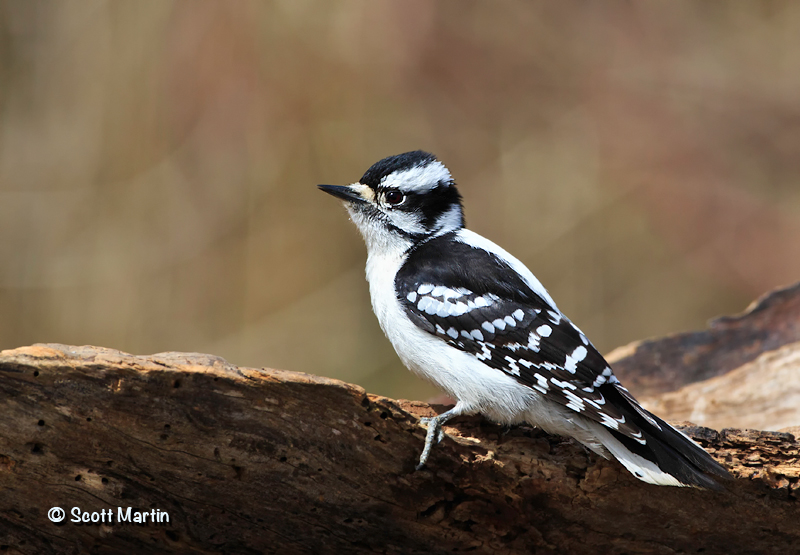
Junco
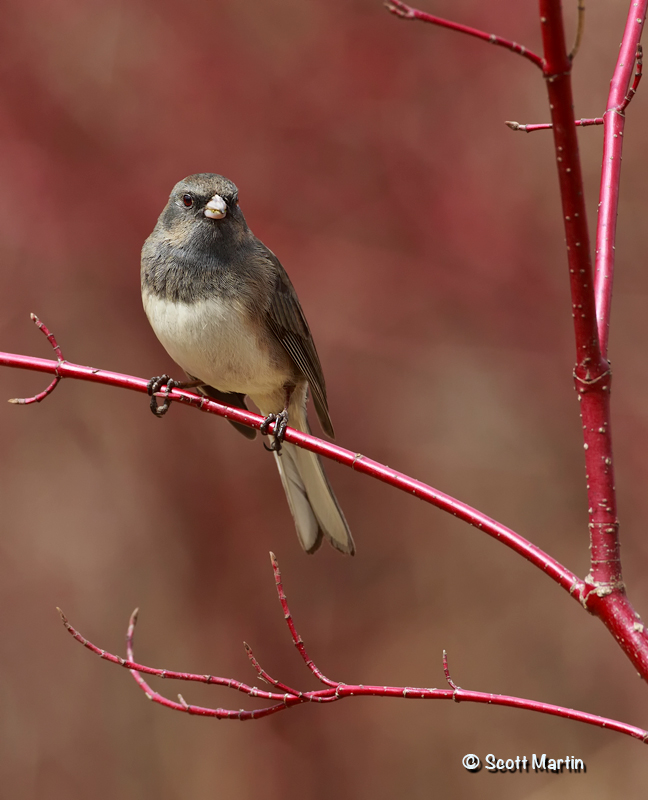
.
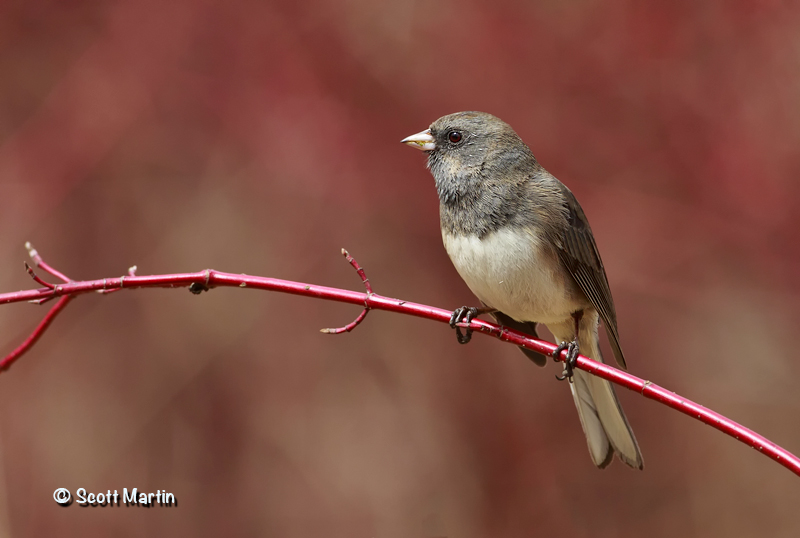
Red Winged Blackbird
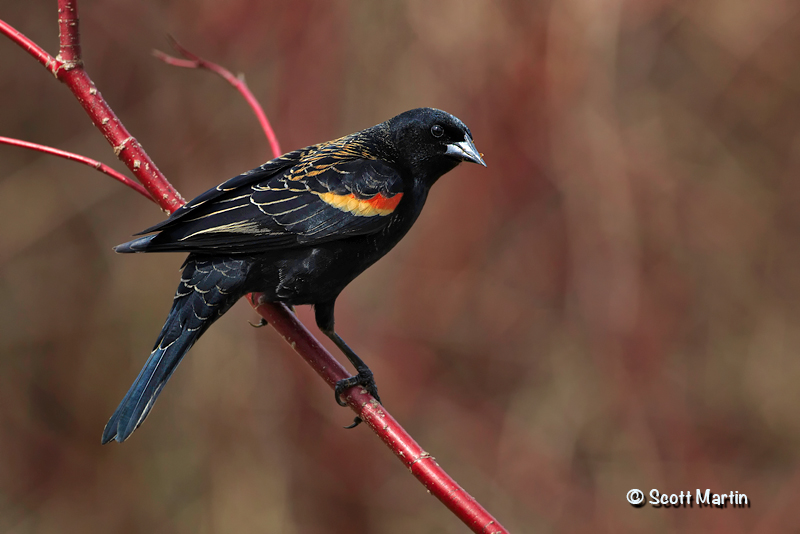
Red Squirrel
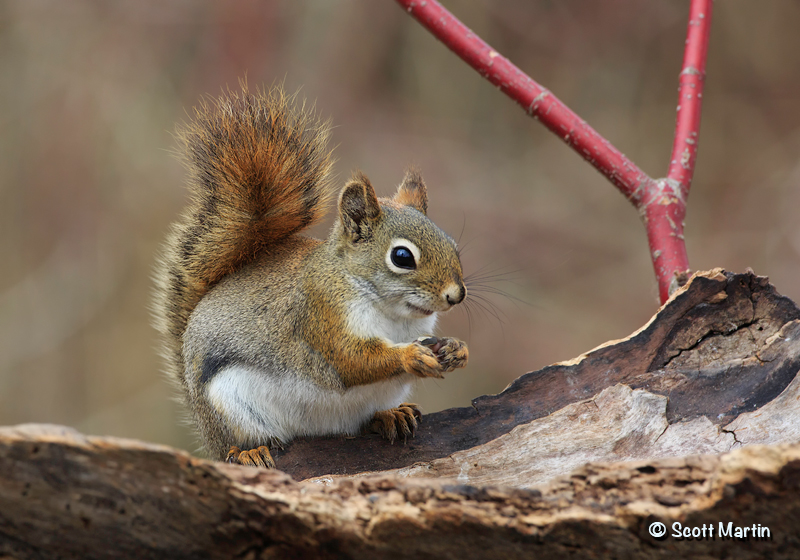
And finally a link to a quick video test of a Red Squirrel
As time permits I plan to post a few more detailed tests of the camera, especially ISO comparisons to help determine how high the ISO can be pushed and still get a useable image.
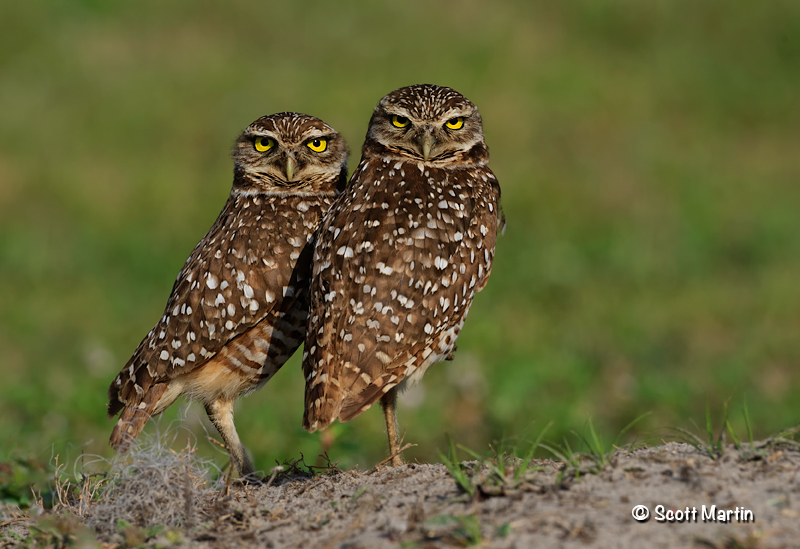
by Scott Martin Photography | Apr 13, 2012 | Birds, Blog, Raptors, Travel
This past year it has been a bit of a challenge to photograph owls and this has led much travel however each mile has been a pleasure, especially in the case of the Burrowing Owl who wisely chooses to live in Florida! Last month we went with our son and daughter in law to photograph Burrowing Owls in Hollywood, Florida which is a suburb of Fort Lauderdale. We visited about six burrows and saw about half a dozen different birds.
Burrowing Owls are small birds approximately 9″ tall with a wing span of about 24″ and have characteristically long legs giving them a unique appearance. They are a relatively common owl found throughout North and South America however as they tend to favour the western parts of the Americas we don’t see them in Ontario. As their name indicates, these small owls live underground, a rarity for animals that fly! Non-migratory Burrowing Owls will occupy the same burrow for many years and spend most of their time very close to the burrow, taking flight to catch bugs and insects or avoid being preyed upon by snakes or even cats. There is not much dimorphism between the sexes however the males tend to be slightly longer and leaner and often lighter in colour which is thought to be due the bleaching effect of the sun on the males who are typically outside of the burrow more than the female.
A good-looking couple!

.
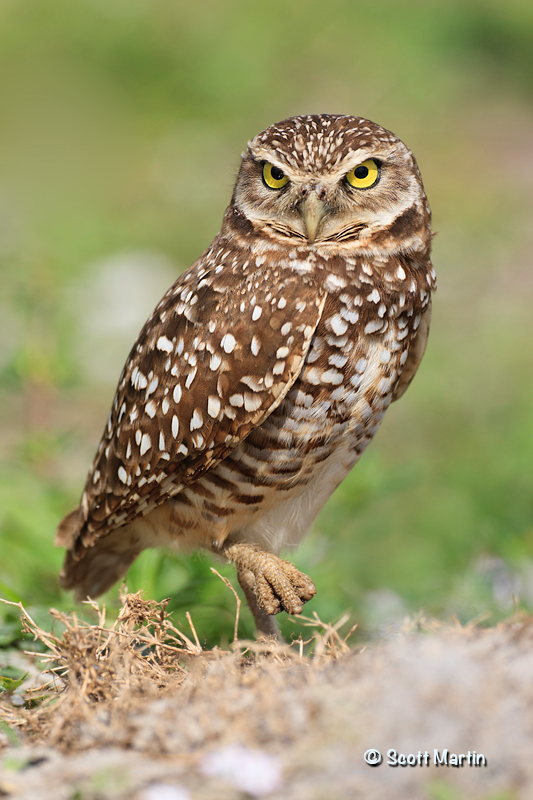
.
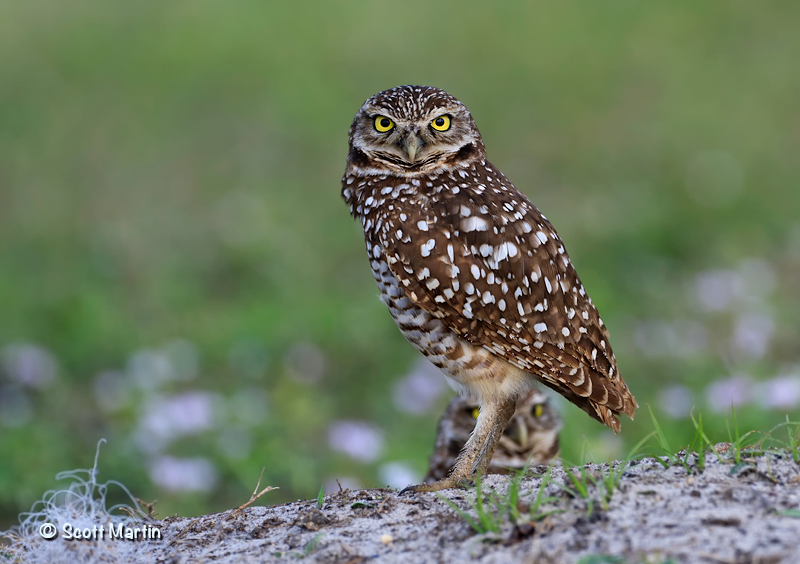
.
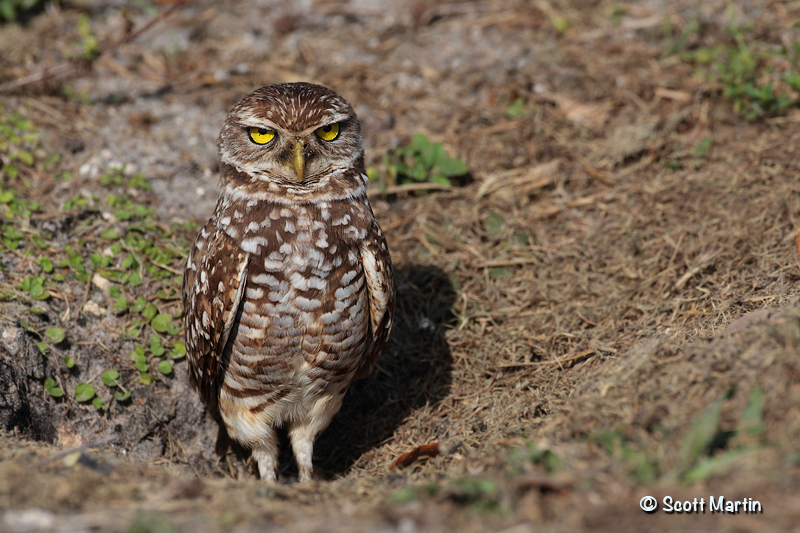
.
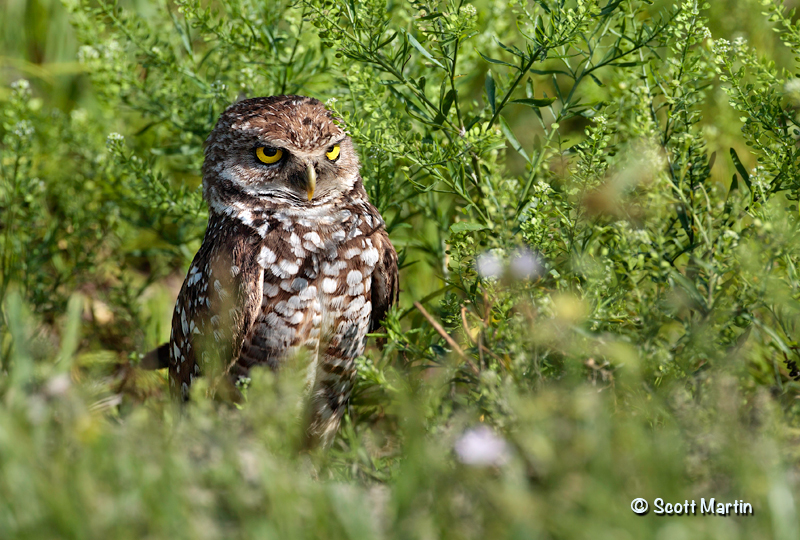
.
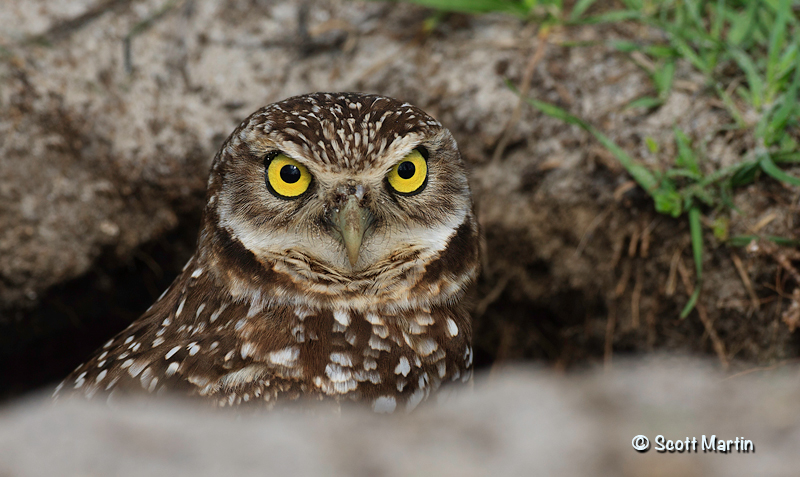
Just to show that Burrowing Owls really do burrow their own homes, even if it means throwing sand on their partner!
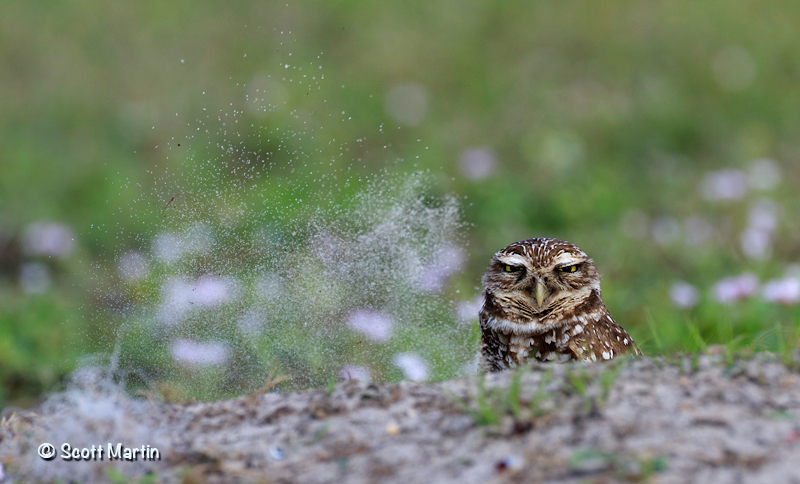
But don’t worry he felt bad and immediately and meticulously removed all the sand 🙂
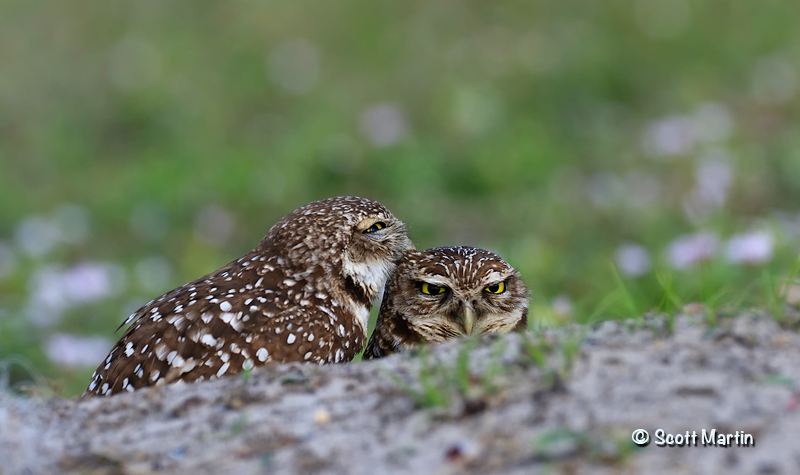
The Burrowing Owl is constantly scanning the environment for threats and responds immediately when one is detected. When I looked around after seeing this expression there was one hawk flying overhead, at least three hundred yards away. Owls are unique in that each of their pupils respond independently to incident light and you can see the different pupil sizes in the following image.
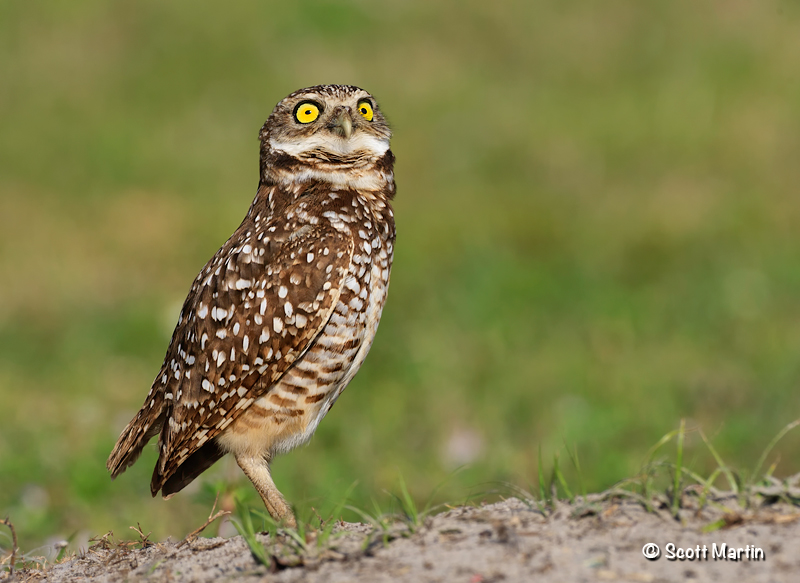
We had an enjoyable time watching the Burrowing Owls as they are quite active through the day although they do most of their hunting between dusk and dawn. The next time you are visiting the sunshine state, you might just want to go looking for a burrow; you will be glad you did!























































Follow Scott Martin Photography